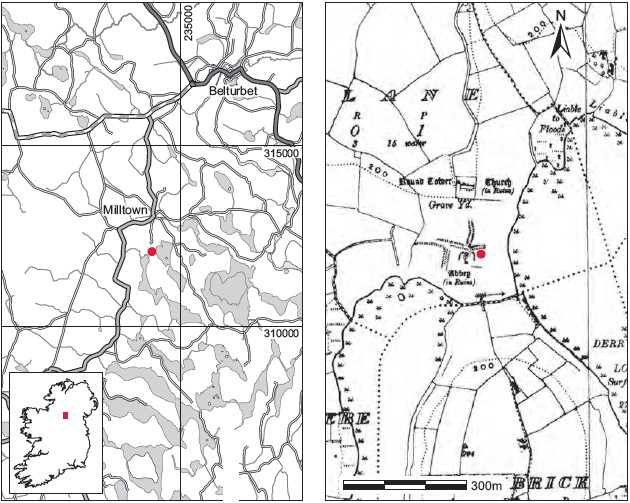County: Cavan Site name: DRUMLANE, CO. CAVAN
Sites and Monuments Record No.: SMR CV014-028 Licence number: E1040
Author: MICHAEL RYAN
Site type: Graves of indeterminate date
Period/Dating: —
ITM: E 634151m, N 812080m
Latitude, Longitude (decimal degrees): 54.056745, -7.478395
Introduction
In late December 1970 human remains were discovered during bulldozing operations near the ecclesiastical site of Drumlane, Co. Cavan. The site was on an out-farm of a landowner, living some 5km away, who was levelling parts of the monastic site for reclamation purposes. During this work a row of human skulls had come to light, and operations were suspended. Some of the human remains were removed for examination by a local doctor and the remainder were left in situ. The site was reported to the Garda Síochána, who informed the NMI. An investigation was carried out by Michael Ryan on 1 January 1971, but the site was not excavated.
Location (Fig. 6.6)
The site was in the townland of Drumlane in west County Cavan, close to the border with County Leitrim.6 The remains were found in the field in which the abbey is situated, approximately 180m south of the church and round tower of Drumlane. The early monastery at Drumlane was already in existence in the sixth century and is associated with St Maedoc and St Colmcille. It was refounded in 1143–8, probably by St Malachy, as an Arroasian house (Gwynn and Hadcock 1970, 170).
Description of site
Before the bulldozing operations began, the visible remains of the abbey appear to have consisted of a masonry wall standing to a height of c. 3m. This comprised part of the south side of a rectangular building elsewhere traceable only by a series of hummocks composed of fallen rubble, which was overgrown. The area of the rectangular building rose about 1m above the level of the surrounding field. Banks of earth and rubble occurred in the field near the site and in those immediately to the west, east and north. At least three of the banks abutted the remains of the rectangular building and had been extensively bulldozed.7
Most of the damage caused by levelling in the area of the abbey building was in the northeast corner. Part of a mortared masonry wall 1.5m in length had been exposed in bulldozing. This wall runs almost due north/south and its relationship with the rectangular building is unclear owing to the level of disturbance. On the west side of this wall human remains were exposed and were apparently piled against it. It was decided only to attempt a minimum amount of clearance for investigation and therefore the stratigraphical position of the.

skeletons in relation to the surrounding structures was not established. The skulls are recorded as having been face downwards and in a row, but at the time of investigation the deposit appeared to be comprised of disarticulated bone. On the west side of the wall described above, a broad track of bulldozing was noted. This had partly cut into the area of the rectangular building. Numerous fragments of dressed stone and mortar were visible in the disturbed soil. Three portions of possible hood moulding of a window or door were noted, as well as a rectangular slab with a triple moulding of round section on the edge. No other finds came to light. The bulldozing had exposed a large area of this site to the effects of erosion.
Comment
In the absence of any associated finds or other evidence it is not possible to suggest a date for these burials. Although they were found close to an early monastic site and later abbey, there is insufficient evidence to associate them with either of these phases of use at the site. The likelihood remains, however, that there is a connection to the church. The human remains were not retained.
6. Parish of Drumlane, barony of Loughtee. SMR CV014-028——. IGR 234208 312071.
7. These banks ran from the west, north and south of the abbey building.